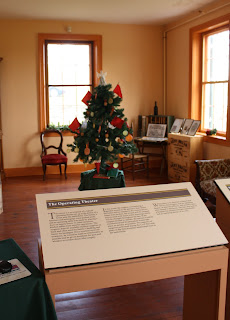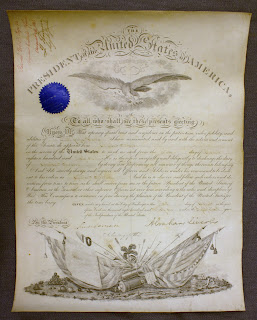Part of my job here at the National Museum
of Civil War Medicine involves helping to tell the stories of the men and women who
were involved with medical care in the Civil War. Sometimes that is accomplished using their
personal belongings or their medical instruments and supplies. These things can certainly give insight into aspects
of their lives or the medical techniques and technology of the time, but it’s
not quite the same as being able to see the face associated with the
objects. I think it is far more
compelling to be able to show that these were real people in the stories that
we tell. So, today I thought I would
share the story and the image of one Civil War Surgeon.
At the start of the Civil War, Orange B.
Ormsby was a young physician in Greenville, Illinois. On June 25, 1861, at the age of 25, he
enlisted as a Private in the 22nd IL Infantry, Company E. His enlistment papers describe him as being
5’ 10” tall, with blue eyes, light hair, and a fair complexion. In August of that same year he transferred to
the 18th IL Infantry, Company S and was commissioned as an Assistant
Surgeon. His claim to fame was that during
the Siege of Corinth, he was working behind Confederate lines and assisted in
saving the life of General Richard Oglesby, who was wounded in the chest and
back. After the war General Oglesby went
on to serve three terms as the Governor of Illinois, and also served as a U.S.
Senator. The town of Oglesby, IL, is
named for him.
 |
| An image of General Richard Oglesby from the National Archives and Records Administration. |
By 1863, Orange B. Ormsby had enlisted as
a Surgeon in the 45th IL Infantry, Company S, also known as the
“Washburn Lead Mine Regiment.” The 45th
IL was assigned to the Army of the Tennessee, and during his time with them
Ormsby would have been in battles in Mississippi, including the Vicksburg
Campaign. In fact, there are monuments
to the 45th IL Infantry in Vicksburg
On October 29, 1864, Ormsby was discharged
for disability (lumbago and rheumatism) and went home to his wife and family in
Illinois. He received an Army pension starting when
he was age 55 and died on June 13, 1899 at the age of 63. Another interesting note is that his youngest
son, Oscar Burton Ormsby, followed in his father’s footsteps by attending
medical school and serving in the medical corps in World War I.
Surgeon Ormsby’s CDV was donated to the
NMCWM by one of his descendants. He
shared the story with me of searching for Ormsby’s grave: I visited Murphysboro,
Illinois in 2004 and found his grave. An
invisible string led me to it as I had no prior indication where it was but was
led (by accident?) directly to it. I
went to the cemetery which was quite large and stopped at a random site, got
out of the car to survey the area and found I was inadvertently located next to
his plot. The hair on the back of my
neck was standing at attention! Perhaps
Orange’s spirit was helping me. I don’t
know but it makes a good story.
Though the CDV image is somewhat faded, we
still wanted to display it. In this
case, the best option was to digitize it.
The digitized image and a brief biography of Orange B. Ormsby are currently
a part of the NMCWM’s video display, “Faces of Civil
War Medicine.” This way Surgeon Ormsby’s
image and his story can be shared with the public, while the original CDV image
can be better preserved for the future.
I hope Orange’s story can be preserved this way as well!
Photos courtesy of the National
Museum of Civil War Medicine, except where otherwise noted.
*Note –
I will be taking a short break for the Christmas holiday, but I look forward to
sharing more blog posts with you in 2013.
Happy Holidays everyone!


.JPG)



















.JPG)













